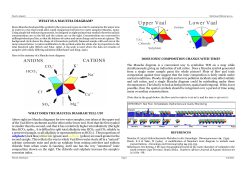
How to Figure Out Chemical Formulas
How to Figure Out Chemical Formulas The Criss-Cross Method The criss-cross method is an easy way to determine the formula of any ionic compound. The ionic compound can be the simple (binary) ionic compound with just two elements, or one that has a polyatomic ion as part of it. All you need is the “combining capacity” of the elements/ions with which you will be working. You can get these combining capacity values directly off of the periodic table for most elements or they are part of the list for either the “shifty” metals and polyatomic ions. How to Criss-Cross Steps (in order) 1. Write the chemical symbols. 2. Write the combining capacities over the symbols. 3. Criss-cross and drop. 4. Reduce – if necessary – the same numbers or a 2 & 4 together. Example: Calcium nitride 1. Ca N 2. Ca2 N3 3. Ca3N2 Try These Formulas Use the criss-cross method to find the formulas for the following. Name of Compound Chemical Formula Beryllium bromide Lithium oxide Potassium nitride Calcium sulfide Magnesium nitride Aluminum phosphide Lithium chloride Sodium sulfide Magnesium oxide Calcium iodide BeBr2 Li2O K3N CaS Mg3N2 AlP LiCl Na2S MgO CaI2 Formulas With “Shifty” Metals The criss-cross method is also used when dealing with metals that have more than one combining capacity value. (Copper, Iron , Lead or Tin) The combining capacity value for these metals can be found in the name of the compound that contains them. Examples: Iron (II) oxide – the Iron (Fe) used here has a combining capacity of 2. Lead (IV) sulfide – the Lead (Pb) used here has a combining capacity of 4. Formulas With “Shifty” Metals Write the formulas for each of the following ionic compounds that feature one of the transition metals. 1. 2. 3. 4. 5. 6. 7. 8. Name of Compound Iron (III) oxide Tin (II) sulfide Lead (II) chloride Copper (II) bromide Iron (II) nitride Lead (IV) oxide Copper (I) phosphide Tin (IV) fluoride Chemical Formula 1. Fe2O3 2. SnS 3. PbCl2 4. CuBr2 5. Fe3N2 6. PbO2 7. Cu3P 8. SnF4 Polyatomic Ionic Compounds Polyatomic ions are clusters of atoms that stay together as one unit and carry an overall charge. Most polyatomic ions are negatively charged. The charge of the polyatomic ion is the same as its combining capacity so that is the number you will use in the criss-cross method. Brackets You may need more than one polyatomic ion in your formula…This means that you will have to use brackets. Use brackets whenever you need more than one polyatomic ion in the formula. Example: Iron (III) nitrate… Start with symbols and combining capacities… Fe3 NO31 After the criss-cross, you may get one of two possibilities… FeNO33 OR Fe(NO3)3 The second option is right because it says you need two nitrate clusters to go with every iron atom. The first option, which did not use brackets, reads as one iron atom with one nitrogen atom and thirty-three oxygen atoms. Fe(NO3)3 is the correct formula! Use those brackets! Polyatomic Ionic Compounds Write the formulas for each of the following polyatomic ionic compounds. Use brackets when necessary. Name of Compound Chemical Formula 1. 2. 3. 4. 5. 6. 7. 8. 9. 10. Sodium nitrate Calcium chlorate Lithium phosphate Aluminum sulfate Tin (IV) carbonate Iron (II) hydroxide Magnesium carbonate Lead (II) bicarbonate Potassium chlorate Ammonium phosphate NaNO3 Ca(ClO3)2 Li3PO4 Al2(SO4)3 Sn(CO3)2 Fe(OH)2 MgCO3 Pb(HCO3)2 KClO3 (NH4)3PO4 Formulas of Covalent Compounds Covalent compounds are between two nonmetals and it involves the sharing of electrons – no bullying involved. The names of covalent compounds have prefixes (starters) that tell you how many of each element is required in the formula. You must remember the prefixes and you must remember that covalent compounds do not reduce to lowest terms like those ionic ones do: Mono – 1 Tetra – 4 Hepta - 7 Di – 2 Penta – 5 Octa - 8 Tri – 3 Hexa – 6 Nona - 9 Examples: Carbon tetrachloride = CCl4 Dinitrogen dioxide = N2O2 Disulfur trihydride = S2H3 Formulas of Covalent Compounds Write the formulas for each of the following covalent compounds. Name of Compound Chemical Formula 1. 2. 3. 4. 5. 6. 7. 8. 9. 10. 1. 2. 3. 4. 5. 6. 7. 8. 9. 10. Carbon dioxide Nitrogen trioxide Trisulfur difluoride Phosphorous pentoxide Dinitrogen triiodide Diphosphorus hexabromide Dihydrogen monoxide Disulfur heptachloride Nitrogen dioxide Carbon monoxide CO2 NO3 S3F2 PO5 N2I3 P2Br6 H2O S2Cl7 NO2 CO THE END
© Copyright 2025





















